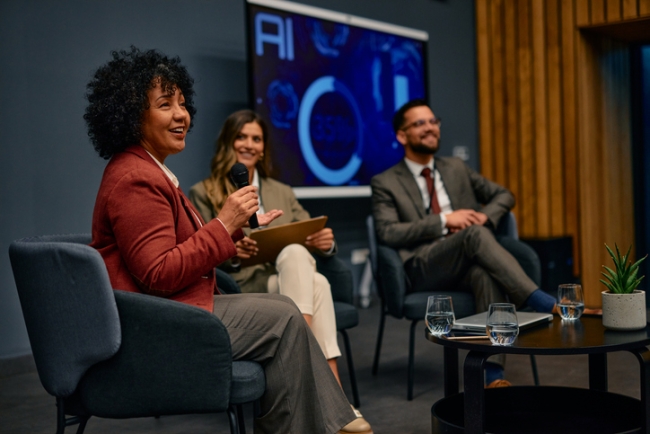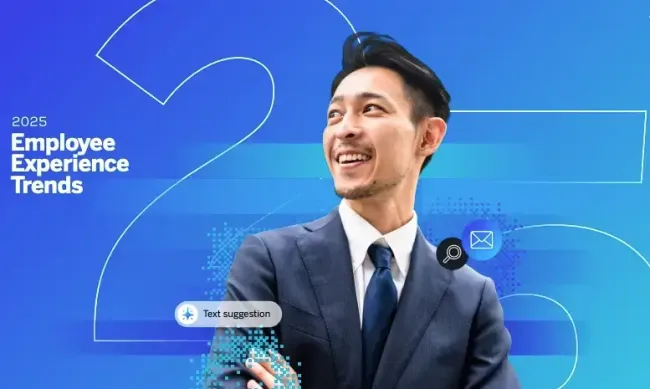Ever since early humans found they could work more efficiently with tools made from flints, contemporary advances in technology have always defined how we work: pottery, irrigation, gunpowder, the magnetic compass, printing, the steam engine, the telephone, the automobile, the computer, space flight, the internet… and now artificial intelligence (AI).
And like the 19th century Luddites who smashed the new power looms that they feared would put them out of work, many 21st century employees worry that the exponential rise of AI will take their jobs too. Do they need to?
Our 2024 employee experience trends report found that employees would prefer to be assisted by AI rather than managed by it – fair enough.
Interestingly, it also found that the more engaged an employee is, the more they are open to using AI at work:

Image: 2024 EX Trends Report p. 14
“Generally, the more positive you feel about your organization – the more trust you have in it – and the more senior your role, the more likely you are to believe that your organization will use AI for your benefit,” says Sarah Marrs, MSc, Director of EX Strategy Execution at Qualtrics. “You also trust that AI will make you more productive and efficient at your job.”
Clearly AI has a role to play in employee engagement, and employee engagement has a role to play in AI.
Free ebook: The State of AI in Employee Experience
What is AI in employee engagement?
Think of it as the automation of knowledge tasks, i.e. complex analysis, communication, problem-solving, pattern learning and more. AI uses machine learning and natural language processing to simulate human intelligence in machines that perform tasks requiring humanlike cognitive abilities.
When it comes to enhancing employee engagement, we can use AI to derive insights from employee data and predictive analytics to help decision making around recruitment, employee performance evaluation, employee experience, and workforce planning.
There are, of course, both benefits and risks.
The benefits of using AI in employee engagement
1. Decision making is data driven
Your organization will be able to uncover deeper insights into aspects of the workplace that are both positively and negatively impacting your employees, by using AI algorithms across a large swathe of employee data.
2. Analytics are more efficient
Insights that might otherwise take many hours of hard work to extract, decipher and analyze can be delivered rapidly to the managers and leaders who need to know. This reduces the admin burden, streamlines the process and frees up time for those leaders and managers to act on the insights.
3. Better employee experience
Using AI-powered tools across your employee data means that experience gaps can be rapidly identified, hyper-targeted with effective actions – and closed.
4. Better employee trust
Many employees, as we’ve discussed above, are wary of AI. However, if you ‘do AI properly’ at your organization (by being transparent, explaining everything and communicating the actions you’re taking as a result of it) employees will see the positive differences and improvements AI makes to their workplace and relationships.
The risks of using AI in employee engagement
1. Privacy and data security
Any collection and storage of employee data and sensitive information carries the risk of security breaches or unauthorized access, so it’s imperative that your security measures are robust, and then some. You must:
- Respect employee privacy rights
- Comply with the relevant data protection regulations
2. Bias and discrimination
Bias and discrimination may be present in historical data which AI may unearth and present as incorrect and misleading insights. It’s crucial that this is addressed by monitoring and auditing AI systems so that they don’t present unsuitable data.
Interestingly, though, our 2024 Employee Experience Trends Report found that employees with disabilities and those who identify as transgender or non-binary reported being more willing to use AI for typically human-centered activities, such as performance appraisals and job interviews, probably because they perceive that AI is less biased than people.
Done well, this is a great opportunity to communicate to all employees that AI is a tool of inclusivity, not bias.
3. Transparency
Some employees may worry that there will be a lack of transparency, control, and possible misuse of their data. It’s essential that organizations build trust by:
- Communicating clearly
- Being transparent about how the data is to be used
- Including employees in decision making processes
4. Quality
We’ve all come across woeful AI creations. If you use substandard AI systems, or the people reviewing and analyzing the data are poorly trained and ineffective, your insights will be unhelpful at best, and even harmful. Make sure your employee listening programs are monitored properly by people with the right training and capabilities.
How can AI be used for employee engagement?
Our research found that employees are open to the use of AI, as long as they have control and can direct it. They accept AI less when it’s being used to evaluate them, or where it impacts upon their careers and livelihoods.
Of the percentage of employees who agree or strongly agree that they would want AI to perform a given task:
- 61% are happy to receive AI help with writing
- 51% are happy to use an AI personal assistant
- 46% are comfortable with using AI to make internal workplace queries
- 37% are comfortable with AI being involved with a performance appraisal
- 29% would want AI involved in their job interview

Image: 2024 EX Trends report p.16
The important thing to remember when using AI to make HR decisions is that employees are humans, and therefore social creatures. Most human decision making is done in a social context, and social decisions carry an emotional component.
“So for more personal and social decisions – such as with a job interview – it’s quite natural for employees to be more hesitant about the involvement of technology that is non-human and non-emotional,” says Dr. Benjamin Granger, Head of EX Advisory Services and Chief Workplace Psychologist at Qualtrics.
The ‘contract’ between employees and AI
When you think about it, any employee listening program – gathering feedback from your workforce and analyzing it – is a contract between employer and employee:
- Employees supply their valuable data – which can be experiential, behavioral, and/or operational. By being frank and honest with their opinions, employees are handing their trust, their confidence, and their time to their employer.
- Employers must provide something valuable in return for this exchange. Particularly in the case of employee listening programs that use AI (that not every employee is comfortable with), it’s absolutely imperative that employers:
- Respect employees’ trust by treating data privacy as paramount
- Select the most trustworthy, reliable, and secure platforms and providers to support the collection and analysis of their data
- Explicitly and transparently communicate with employees about how their data will be used
- Identify and mitigate biases in the data and uphold the principles of fairness and equity
- Reward their contribution by using employees’ data to close experience gaps quickly and make their working lives easier and more enjoyable
- Don’t depend excessively on AI technology, but instead use the data and tools in a responsible and ethical manner, always keeping in mind that they’re dealing with real people.
AI employee engagement tools
There are many ways that AI tools can do the ‘heavy lifting’ by automating previously tedious, time-consuming tasks, while also unearthing insights that would otherwise be overlooked.
The most useful are:
HR services
HR professionals and their teams are better utilized when they can focus on more strategic, action-driven tasks. AI automation tools can take on routine tasks such as interview summaries, administration, policy look-ups, document generation, workplace queries, inbox triage and responding to simple HR questions.
Chatbots and virtual assistants
AI customer service technology can help teams become more efficient with their time. Chatbots enable better self service and reduce call volumes, while interactive voice response (IVR) triages the most important customer calls. AI can also handle repetitive tasks such as post-call summaries and issue logging.
AI helps free up your customer teams to handle the most important or difficult customer inquiries and prevents them from getting stuck in administrative tasks, helping them to be more efficient and feel greater employee satisfaction.
HR ‘Co-pilots’
Real-time coaching and guidance for managers and leaders, which help HR teams to support them at any point during the working day.
Predictive analytics
The poster child for AI, predictive analytics takes real time data across every touchpoint, combines AI-powered insights with operational metrics and delivers preemptive insights so that you can intervene in a situation, sometimes before it even happens.
Performance management systems
AI systems are helping performance management to evolve to be more agile, collaborative – and human. Modern performance management software now uses AI and machine learning to analyze employee performance data, and track employee progress and company-wide performance far more holistically.
Talent management
Because this is data driven, with relevant information streamed into and analyzed in a central location, your HR and people teams can make rapid, evidence-based decisions about your workforce using joined-up, reliable and trustworthy data.
In the case of talent management, predictive analytics can pinpoint employee behavior and danger points that may trigger your top people to leave – so you can stage an intervention to keep them and improve employee retention.
The voice of the employee
AI-powered tools can capture more and richer employee feedback at scale, so people leaders and managers no longer need to collate or analyze it manually. These tools can automatically segment the workforce, produce consolidated summaries, prepare action items and supply role-based at-a-glance takeaways for users.
The most up-to-date AI-powered solutions such as Qualtrics®XM for Employee Experience pair the power of generative AI with the world’s largest database of human sentiment to help managers and people leaders elevate workforce engagement, increase retention and champion productivity.
This can:
Identify attrition drivers in the workforce
Organizational attrition data gets combined with employee experience feedback to shed light on what’s making employees leave. For example, it can pinpoint frictions in the onboarding process that are making new hires leave prematurely, and deliver the information to leaders via dashboards so they can rapidly address bad experiences, and hone retention strategies that minimize turnover.
Anonymize and summarize employee comments
Using open text survey responses, AI can pick up and collate important team issues and valuable feedback, while protecting employee privacy and reducing the risk of bias from identifying commenters.
Surface deeper, actionable insights from EX feedback
By asking simple, natural-language questions about their team feedback results, the AI in Qualtrics Assist™ can pull up deeper insights and trends, leading to a better understanding of team sentiment and what actions to take.
Recommend personalized actions in response to employee feedback
Our research found that just 43% of individual contributors say they have seen positive changes in response to employee feedback. Clearly there’s a need for specific, targeted action. By combining AI with EX methodology you’ll be able to offer personalized, tailored guidance that enhances the team dynamic, and helps managers take better-informed and decisive actions.
A final thought on leveraging AI
The world of AI-driven systems may unsettle some employees. But, if organizations prove they are driving improvements by using them, they can build trust. Emphasize transparency, explain, and communicate action. By doing these three things, organizations will lessen the risk of coming across as ‘Big Brother’ watching employees’ every move, and relationships between employees and leadership will improve.



